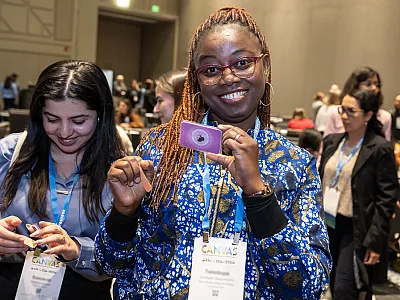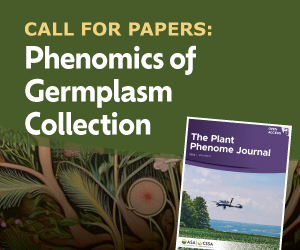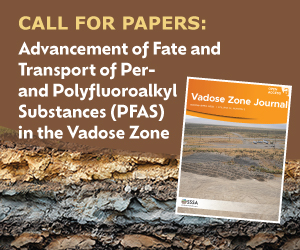A Good Model to Follow
Laj Ahuja Encourages Young Scientists to Focus on Solutions to Global Challenges, Help Others
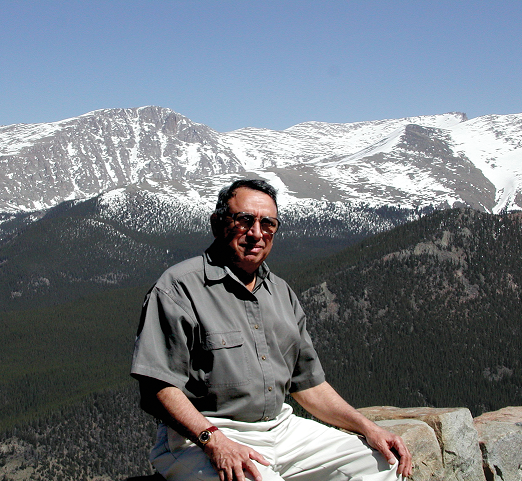
Happiness in heart and mind comes from helping others,” states ASA and SSSA Fellow Laj Ahuja. Measuring his life in what he has contributed to the science community and how he has helped others, Ahuja is grateful for his many opportunities.
Born in the west Punjab region of India in 1935, Ahuja and his family navigated many challenges. His father passed away before his birth, and Ahuja was raised by his mother with the help of other family members. When he was 12, India was divided into two countries, India and Pakistan, forcing his family to relocate to the east. With the country in a state of extended upheaval, the resulting unrest impacted every facet of life, resulting in multiple moves for Ahuja’s family during his school years.
Journey into Soil Science
Wanting to remain near family and continue his education, Ahuja attended college in Delhi. At the University of Delhi, he received a bachelor of science in agronomy and chemistry. He then had an opportunity to work in the Himalayas (Himachal Pradesh), assisting farmers in adopting improved agricultural methods. Pursuing an interest in crops at the Indian Agriculture Research Institute, he acquired his master’s in soil and water with research focused on water management, micronutrients, and hybrid corn. He worked as an assistant professor for a year in an agriculture college in Solan, India and then began his Ph.D. studies at IARI before winning a small scholarship that funded his dream of coming to the United States to pursue his doctorate at the University of California–Davis (UC‐Davis) from 1965–1968.
It was at UC‐Davis that Ahuja began his journey in soil physics. Under the tutelage of Donald Nielsen, Ahuja became intrigued by soil physics because it integrates the entirety of agriculture under one roof. This system approach has permeated Ahuja’s work.
Ahuja held several research and teaching positions before joining USDA‐ARS’s National Water Quality Lab in Oklahoma in 1979, working as a research soil scientist. In 1991, he transferred to Fort Collins, CO, to work as a research leader at the former Great Plains Systems Research Lab, remaining there until his retirement in 2017.
At the USDA, Ahuja gradually moved from experimental soil physics research that fostered a broader understanding of soil science into an inclusive approach of modeling systems, emphasizing the practical applications of his work.
Altering the Understanding of Soil Physics
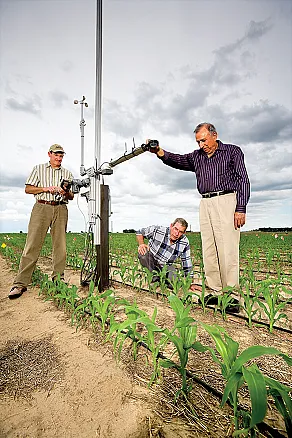
“Laj was known for his important contributions to infiltration and runoff, water and chemical transport in soils and runoff, macropore flow, and effects of soil properties and management on infiltration and drainage,” recalls ASA and SSSA Fellow Dennis Timlin, who worked with Ahuja in Oklahoma as a post‐doc researcher. “He also started putting together databases of soil hydraulic properties as related to soil texture with a team of other researchers to develop predictive functions for water retention and hydraulic conductivity known as pedo‐transfer functions. More importantly, he had a strong interest in mathematical approaches to quantify these processes that deepened, and in some cases altered, our understanding of soil physical processes as an interrelated system.”
Ahuja firmly believes that research should result in practical information that will aid producers. Knowledge is indeed power, but it is in the application of that knowledge to benefit others where Ahuja finds purpose and satisfaction.
“Laj’s contributions to basic soil science are original and quantitative,” says ASA and SSSA Fellow Liwang Ma, USDA‐ARS Rangeland Resources and Systems Research Unit research soil scientist. “He has been a pioneer in addressing knowledge gaps in soil science in the systems context.”
Models Extend Research and Solve Problems
“Combining modeling with field studies provides more information than is available through research alone,” Ahuja says.
Modeling systems allow the data to be extrapolated and parameters varied to provide a range of useful information. Ahuja and his team have worked on models for water quality and the impact of agriculture on water quantity and quality. His models have been used to better manage nitrogen and pesticides, predict rangeland grazing conditions, optimize water use in irrigated systems, and evaluate the impacts of climate change on agriculture systems.
“While in Oklahoma, Laj saw the importance of a systems approach to agricultural management, and with his mathematical and programming expertise, began to incorporate his extensive soil physics research into a system model called the Root Zone Water Quality Model (RZWQM),” Timlin says.
Unique to the RZWQM are Ahuja’s pioneering quantifications of tillage effects, soil‐water dynamics, and the faster transport of surface‐applied chemicals through macropores in no‐till soils.
The model has been refined due to Ahuja’s passion for sharing his work and inviting others from around the world to collaborate on research and testing. As a way to assess cropping systems and management, RZWQM has been used to evaluate and minimize water quality impacts, specifically N and pesticides, in different agricultural systems worldwide. Implementing management practices suggested by the model resulted in efficient irrigation practices and reduced nitrogen losses in China. In Iowa, the model improved the understanding of controlled tile drainage and cover crops on nitrogen losses and assisted the USEPA in evaluating the environmental impacts of pesticides.
Ahuja and his team’s other model, Great Plains Framework for Agricultural Resource Management (GPFARM), is the only decision tool of its kind integrating farm and ranch management. Designed specifically for use by farmers, ranchers, and agriculture advisers in the Great Plains region, GPFARM is being used to evaluate long‐term management and environmental effects on production and economics.
The stand‐alone GPFARM Range‐Livestock model addresses range management challenges. This system model has been used to synthesize experimental data on grazing intensities at ARS stations in Wyoming, Montana, and Oklahoma and predict future forage levels based on soil moisture. This enables ranchers to plan ahead for adjustments in stocking densities to better match forage availability with livestock numbers.
Under Ahuja’s leadership, his ARS team also created an Object Modeling System (OMS) to build modular models created from a library of existing science and auxiliary modules. “OMS models are easier to develop, update, and transfer to the next generation. OMS models are customizable for a region, problem, and data available while significantly reducing development costs,” Timlin notes. The OMS framework has been used by USDA‐NRCS to streamline the building and delivery of its conservation plan and design tools.
Impacting Others
Ahuja has had an impact in both mentoring and in service to the Societies. He has mentored more than 40 visiting scientists, multiple graduate and post‐doctoral students, and countless young scientists. Within the Societies, he has served on 12 SSSA–ASA committees, including as assistant editor, technical editor, and book review editor.
In 2006, Ahuja initiated a book series with the Societies focused on gathering and sharing systems modeling information, Advances in Agricultural Systems Modeling. “Systems models are difficult to publish, yet extremely important since each integrates different factors to predict real‐life occurrences,” Timlin notes. “His vision led to concentrating these works into one place to extend the application of modeling so others could benefit.” Although he had offers to publish the series elsewhere, Ahuja says that “Publishing with the Societies has brought me much greater joy.”
Ahuja established and served as the first leader of ASA’s Agroclimatology and Agronomic Modeling Community. He also established an SSSA Indian University Graduate Student Travel Award to help recent graduates attend the Annual Meeting and donated support for the Agricultural Systems Modeling Award to recognize research scientists who are advancing the application of modeling systems.
With the assistance of the Societies, Ahuja’s efforts to encourage and support those scientists who are working on systems modeling are bringing attention to this needed whole‐system approach to soil science.
According to Timlin, Ahuja went out of his way to introduce young scientists to leaders in their field of interest, help them publish their work, recommend them for speaking engagements, and encourage them to apply for positions.
“I am very fortunate to have met and worked with him as a postdoc. I can honestly say his work and mentoring shaped me and my approach to soil science,” says Timlin, who is working with the USDA to assess the effects of climate change on crops and develop models for future use. “The work I am doing now, crop simulation research, came out of my time with Laj.”
Looking to the Future
Ahuja's advice to young researchers is to follow their interests and help others, look at the challenges facing the world, and focus on solutions. He sees the big hurdles currently facing scientists as water availability and quality and climate warming.
For example, he sees the overuse of chemicals as a growing global concern. The overuse of nitrogen, phosphorus, and pesticides increases producer costs but also impacts water quality from communities all the way to oceans. Finding solutions at the application level can produce sustainable yields with fewer chemicals resulting in positive environmental impacts.
Ahuja's analytical thinking and pioneering original research have been driven by a passion for solving problems and helping others. With the entire science community focusing on climate change and pushing to adopt more sustainable practices, agricultural system models are contributing to the health and prosperity of individuals around the world.
DIG DEEPER
Interested in checking out some of the books in the modeling series, Advances in Agricultural Systems Modeling, mentioned in this article? You can receive 20% discount using the code “3SA20”. Go to Wiley.com and search for the book title to place order.
Text © . The authors. CC BY-NC-ND 4.0. Except where otherwise noted, images are subject to copyright. Any reuse without express permission from the copyright owner is prohibited.






